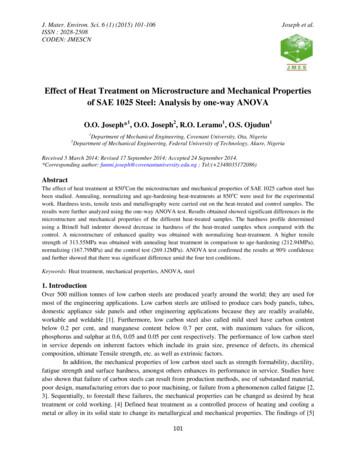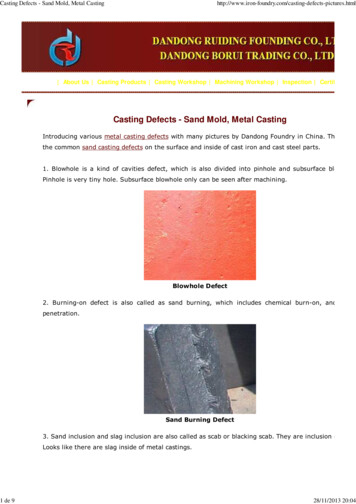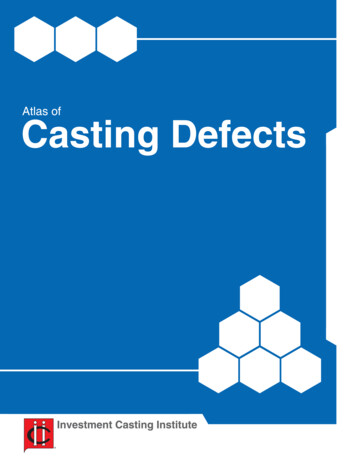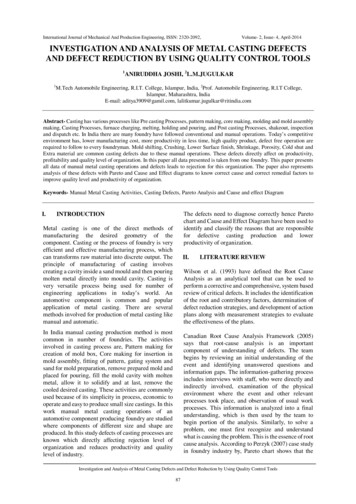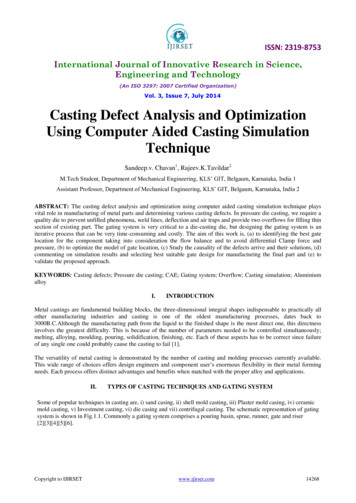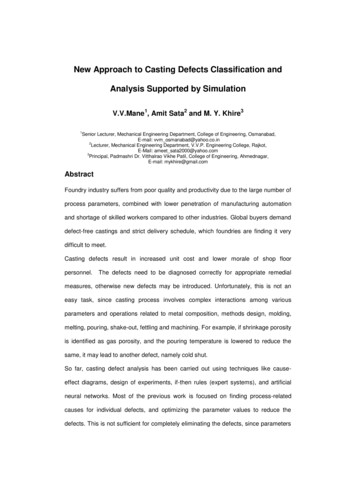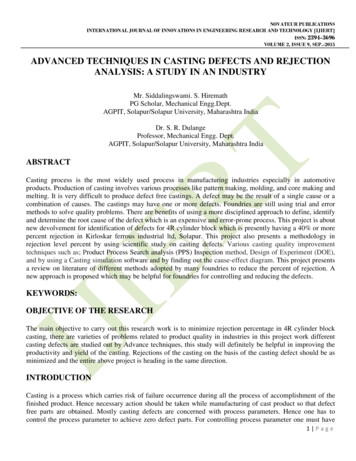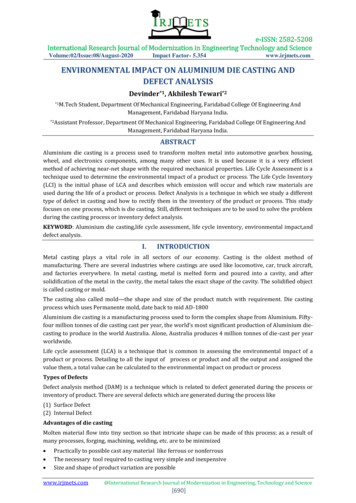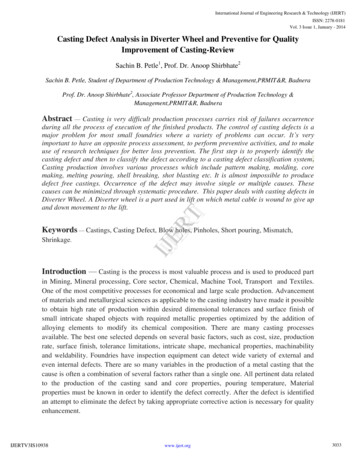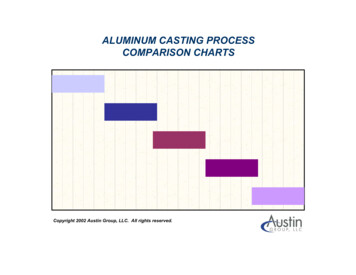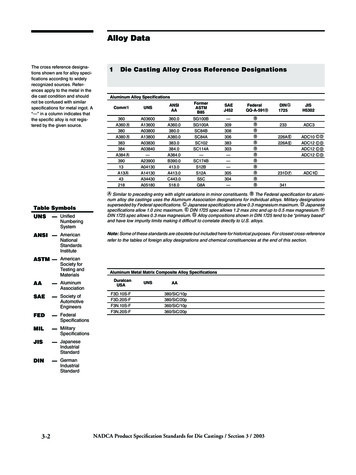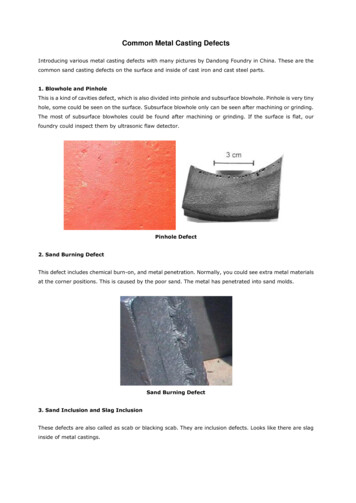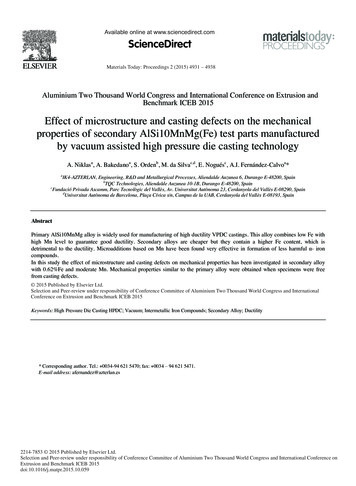
Transcription
Available online at www.sciencedirect.comScienceDirectMaterials Today: Proceedings 2 (2015) 4931 – 4938Aluminium Two Thousand World Congress and International Conference on Extrusion andBenchmark ICEB 2015Effect of microstructure and casting defects on the mechanicalproperties of secondary AlSi10MnMg(Fe) test parts manufacturedby vacuum assisted high pressure die casting technologyA. Niklasa, A. Bakedanoa, S. Ordenb, M. da Silvac,d, E. Noguésc, A.I. Fernández-Calvoa*aIK4-AZTERLAN, Engineering, R&D and Metallurgical Processes, Aliendalde Auzunea 6, Durango E-48200, SpainbTQC Technologies, Aliendalde Auzunea 10-1B, Durango E-48200, SpaincFundació Privada Ascamm, Parc Tecnològic del Vallès, Av. Universitat Autònoma 23, Cerdanyola del Vallès E-08290, SpaindUniversitat Autònoma de Barcelona, Plaça Cívica s/n, Campus de la UAB, Cerdanyola del Vallès E-08193, SpainAbstractPrimary AlSi10MnMg alloy is widely used for manufacturing of high ductility VPDC castings. This alloy combines low Fe withhigh Mn level to guarantee good ductility. Secondary alloys are cheaper but they contain a higher Fe content, which isdetrimental to the ductility. Microadditions based on Mn have been found very effective in formation of less harmful α- ironcompounds.In this study the effect of microstructure and casting defects on mechanical properties has been investigated in secondary alloywith 0.62%Fe and moderate Mn. Mechanical properties similar to the primary alloy were obtained when specimens were freefrom casting defects. 20152014PublishedElsevier Ltd.All rights by r-reviewunderresponsibilityof ConferenceCommitteeof AluminiumTwo ThousandWorld CongressandSelectionunderresponsibilityof ConferenceCommitteeof AluminiumTwo ThousandWorld Congressand InternationalConferenceonConferenceExtrusion and2015onBenchmarkExtrusion ICEBand BenchmarkICEB 2015.InternationalKeywords: High Pressure Die Casting HPDC; Vacuum; Intermetallic Iron Compounds; Secondary Alloy; Ductility* Corresponding author. Tel.: 0034-94 621 5470; fax: 0034 – 94 621 5471.E-mail address: afernandez@azterlan.es2214-7853 2015 Published by Elsevier Ltd.Selection and Peer-review under responsibility of Conference Committee of Aluminium Two Thousand World Congress and International Conference onExtrusion and Benchmark ICEB 2015doi:10.1016/j.matpr.2015.10.059
4932A. Niklas et al. / Materials Today: Proceedings 2 (2015) 4931 – 49381. IntroductionPrimary aluminium-silicon-magnesium alloys are by far the most widely used type in the manufacturing of safetyparts for the automotive industry, such as suspension components and wheels, due to their excellent castability andgood mechanical properties [1] which can be further improved by heat treatment: solution treatment followed bywater quenching and subsequent artificial aging T6 or T7. Until the introduction of thin walled structural parts in the1990’s, these safety critical components were mostly produced in permanent mould. The more recent structuralcastings, being extremely thin walled (of the order of 2.5 mm) and of large dimensions usually require the use ofhigh pressure die casting. These parts must be free of defects and heat treatable in order to attain the requestedproperties. Vacuum has to be applied for achieving ductility and weldability and precautions relative to the diedesign, die lubricant, melt quality and shot profile are also mandatory.Conventional HPDC alloys are usually secondary alloy, in which iron is intentionally in the range of 0.81.1 wt. % in order to prevent molten metal soldering to the die [2-4]. However, conventional HPDC alloys andprocesses are not employed for high ductility castings and safety parts due to the presence of large β-Al5FeSicompounds. For this reason, the primary AlSi10MnMg alloys with a maximum iron content of 0.25 wt. % and highMn to avoid die soldering were developed [5]. Nevertheless, the use of recycled alloys with high iron content canreduce significantly the production costs of a part by increasing die life. It should be noted that die manufacturingand maintenance make up more than 10 % of HPDC manufacturing. Additionally, secondary alloys are cheaper andtheir production requires much less energy and generates less CO2 emissions.It is well known that addition of elements such as Mn, Cr, Sr, Co, Be and Ca can neutralize the effect of the brittleβ iron compounds by substituting them by D-iron compounds with a less harmful morphology. The effect of thesemicroadditions on the iron compounds in aluminium casting alloys has been investigated by several authors [6-11].The present work investigates the microstructure and mechanical properties of both, a primary alloy with high Mnand low Fe content and a secondary AlSi10MnMg(Fe) alloy with high iron content and moderate addition of Mn in astep test part, manufactured by VPDC technology in the as cast and T6 heat treated condition. The effect of castingdefects on mechanical properties, in particular ductility has also been studied.2. Experimental procedureA Buhler cold chamber HPDC machine with a maximum locking force of 5250 kN, a plunger with a diameter60 mm and a stroke of 450 mm was used in the tests. In the first step of the injection process the plunger wasconstantly accelerated in order to reduce the gas entrapment during this phase. The velocity was kept constant in thesecond phase, filling of the die cavity. The plunger velocity was 4.5 m/s in order to ensure the filling of the sectionof 1 mm. The metal velocity at the ingate section was 44 m/s. A VDS vacuum system, activated and deactivated byinteraction with HPDC machine, was used. A ProVac Ultra Easy 2000 valve and a ProVac CV 300 chill vent wereemployed to achieve a vacuum level between 85 and 100 mbars. The vacuum in the die allowed also the properfilling during the second phase. The third phase, the compression phase, started when the plunger felt abackpressure. The metal pressure was between 900 and 950 bars in the compression phase. For each experiment,350 kg of each alloy were melted in an electric furnace. The alloys were modified using AlSr10 master alloy, pureMg was added in order to keep the concentration of Mg between 0.3 wt. % and 0.40 wt. % in the melt. The melt wasdegassed with argon using a rotor impeller reaching D80 values of more than 2.62 g/cm3. The control of oxides wasalso made using the K-Mould. An automatic ladle was used to extract the metal from the furnace at a temperaturebetween 700 ºC and 720 ºC and pour into the shot sleeve.The chemical compositions of the alloys used in this work are presented in Table 1. Alloy A is a typical primaryAlSi10MnMg alloy for VPDC castings with a Mn content of 0.68 wt. % and low Fe content of 0.17 wt. %. Alloys Bis a secondary alloy with 0.62 wt. % of Fe and a Mn content of 0.42 wt %. The Mn content has been optimisedpreviously [11] regarding the elimination of β-iron compounds. The higher Cu and Zn content present in alloy B incomparison to the primary variant, is typical of recycled aluminium. The primary alloy presents a slightly higher Mgcontent. Both alloys have Sr addition for eutectic Si modification. The total of Mn Fe is higher in alloy B(1.04 wt. %) than in alloy A (0.85 wt. %), this is expected to have a positive effect with respect to die soldering.
4933A. Niklas et al. / Materials Today: Proceedings 2 (2015) 4931 – 4938According to the Gobrecht [12] at a pouring temperature around 680 ºC (typical of HPDC process), the sludgefactor, SF [%Fe] 2[%Mn] 3[%Cr] should be less than 2.2. As it is shown in Table 1, both alloys present a similarvalue (alloy A: 1.53 and alloy B: 1.49 wt. %) and are well below 2.2. Thus, the precipitation of coarse intermetallicsis not expected.Table 1. Chemical composition (wt. 370.010.010.030.04*The primary alloy corresponds to the quality ENAC 43.500 according to the norm UNE-EN 1706:2011.Sr0.00610.0101Total Fe Mn0.851.04SF1.531.49The die was designed to fabricate a step test piece with a width of 170 mm and wall thicknesses of 1, 2, 4, 6, 10and 15 mm [11]. Mechanical properties have been determined in the 2 and 4 mm steps. The characteristics andchemical composition of the intermetallic iron compounds were examined using scanning electron microscopy(SEM) with an energy dispersive X-ray spectrometer (EDS). For the quantification of area fraction of intermetalliccompounds, twenty images were obtained at a magnification of 2000X. The area fraction of each compound wasestimated using a LAS V4.2 image analyzer.Both alloys were subjected to a T6 heat treatment consisting of solution treatment at 490 ºC for 3 h, waterquenched and aged at 165 ºC for 3 h. The heat treatment has been optimized previously regarding solutiontemperature and time in order to avoid blister formation. Subsequently flat tensile specimens were preparedmaintaining the casting skin and tested according to UNE-EN ISO 6892-1:2010.3. Results and Discussion3.1. MicrostructureThe microstructures formed in the 2 mm step of the as cast (F) test piece of both, primary and secondary alloy,are shown Figure 1. The microstructures of the as cast alloys, F Temper (Figures 1a -1b) present the followingphases: primary aluminium, eutectic Al-Si, Mg2Si and D-Al15(FeMn)3Si2 and S-FeMg3Si6Al8 intermetallic ironcompounds. After T6 heat treatment no large Mg2Si phases are observed indicating the solution heat treatment waseffective. Furthermore, the eutectic Si grows in size and becomes globular; the iron compounds are not affected byT6 heat treatment (Figures 1d -1e). Additionally, small gas pores appear in the microstructure (Figures 1c and 1f).The intermetallic iron compounds were characterized in the scanning electron microscope (Figure 2). In themicrostructure of both alloys two sizes of D compounds can be observed. The large D compounds have a sizebetween 10–16 Pm and are probably primary phases which have formed in the shot sleeve, while the formation ofthe small Dparticles occurred during solidification in the die. No large β iron compounds ( 20 Pm) have beendetected in both alloys.The compositions of D and S compounds are summarized in table 2. The D iron compounds of both alloys haveFe and Mn in the composition. As expected from the chemical composition of the alloys used for manufacture of thetest parts the D compounds have a higher Mn content in the primary alloy and a higher Fe content in the secondaryalloy. Small quantities of Mn are also detected in S iron compounds; again its amount is higher in the primary alloy.Table 2: Chemical composition of D and S compounds in wt. % determined by EDS analysis.AlloyPrimary ASecondary e 3 shows the area fraction of all intermetallic iron compounds in the steps of 1, 2, 4, 6 and 10 mm for bothalloys. It can be seen that the primary alloy A shows a lower area faction of intermetallic D iron compounds than thesecondary alloy B. Furthermore, a small decrease of area fraction with reduction of wall thickness is observed.
4934A. Niklas et al. / Materials Today: Proceedings 2 (2015) 4931 – 4938Several authors observed the same decrease of area fraction when cooling rate increased, and they attributed this to adelay in the growth mechanism of the intermetallic iron compounds [13-14].Temperab D-ironcompoundcompoundD-Alc D-ironMg2SiS-ironeutecticAl-SicompoundT6 TemperdefFigure 1. Microstructures observed in the 2 mm steps. Microstructures in the F temper: a) the primary alloy, b) and c) thesecondary alloy; Microstructures in the T6 temper: d) the primary alloy, e) and f) the secondary alloy.abDScSpectrum 6AldDFeMnSFeSiV0123Full Scale 13713 cts Cursor: 0.000V45Mn6MnFe78910keVFigure 2. Intermetallic phases and EDS analysis of D phases in the 2 mm step, a) and b) the primary alloy; c) and d) the secondaryalloy.
4935A. Niklas et al. / Materials Today: Proceedings 2 (2015) 4931 – 4938Area fraction (%)2.52.01.51.0Primary alloy A(0.17%Fe 0.68%Mn)0.5Secondary alloy B(0.62%Fe 0.42%Mn)0.0024681012Wall thickness (mm)Figure 3. Effect of wall thickness on the area fraction of the intermetallic iron compounds.3.2. Mechanical propertiesThe tensile properties of both alloys have been determined for the 2 mm step in F and T6 temper (see Table 3).The secondary alloy has been tested additionally in the 4 mm step. Macrographs of the corresponding fracturesurfaces are shown in Table 4 and representative micrographs of the observed defects, lamination, cold shut, coldflake and gas porosity, are presented in Figure 5. Lamination and cold shuts occur if partially solidified layers ofmetal flows come together and do not knit. Whereas, cold flakes are formed when the molten metal is poured intothe shot sleeve and a skin of solidified aluminium is pushed by the plunger into the die cavity during filling [15].Gas porosity in HPDC is usually due to the decomposition of coolant and die lubrication or entrapped air [15, 16].It can be observed, that elongation is strongly influenced by the presence of large sized casting defects, while theyield strength and ultimate tensile strength are less affected. The latter observation can be related to the orientationof defects with respect to the tensile direction. Aziz Ahamed et al. [18] reported that when the cold flakes areparallel or slightly inclined from the tensile direction no major effect on ultimate tensile strength is observed, whilein case of perpendicular defects a linear decrease of tensile strength with the defect area occurred. In this study areduction of elongation was observed as the size of the defect increases. Cold flakes/cold shuts/laminations, whichhave quite large sizes, reduce elongation significantly (Figure 6a). Whereas, the area fraction of gas porositymeasured on the fracture surface of the test specimen was qui
The effect of casting defects on mechanical properties, in particular ductility has also been studied. 2. Experimental procedure A Buhler cold chamber HPDC machine with a maximum locking force of 5250 kN, a plunger with a diameter 60 mm and a stroke of 450 mm was used in the tests. In the first step of the injection process the plunger was constantly accelerated in order to reduce the gas .Author: A. Niklas, A. Bakedano, S. Orden, E. Nogués, A. I. Fernández-Calvo, Cerdanyola del VallèsPublish Year: 2015
